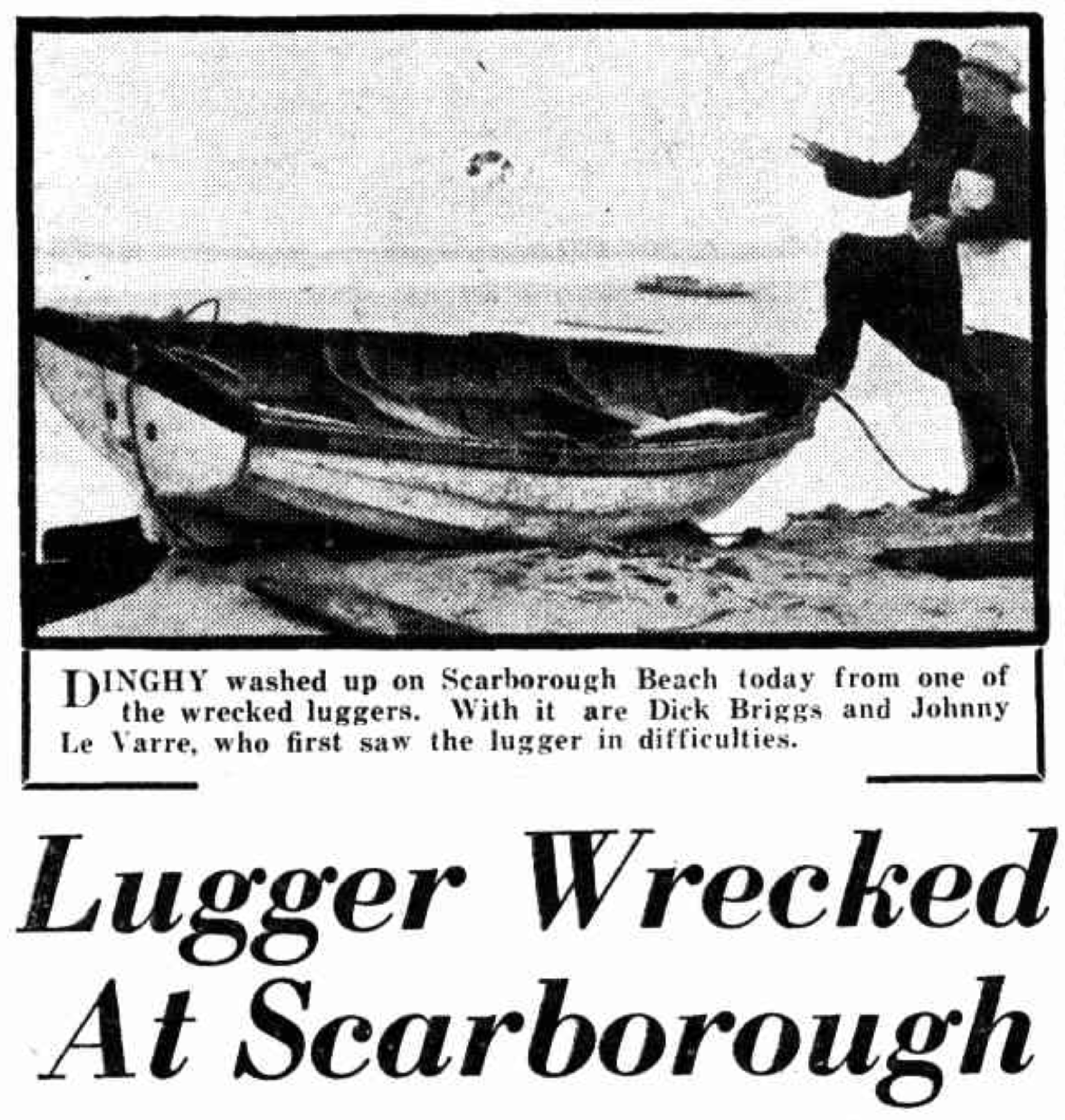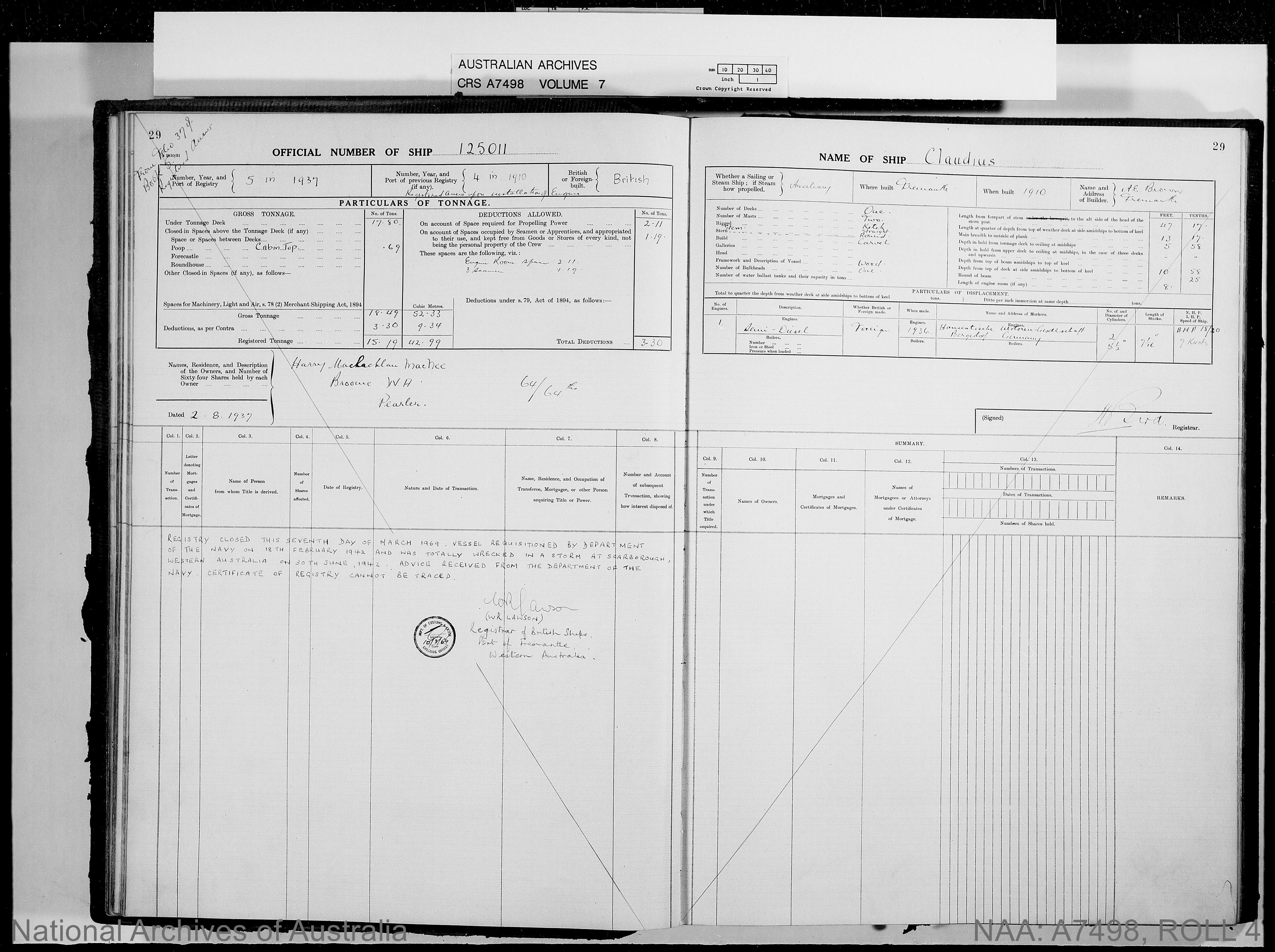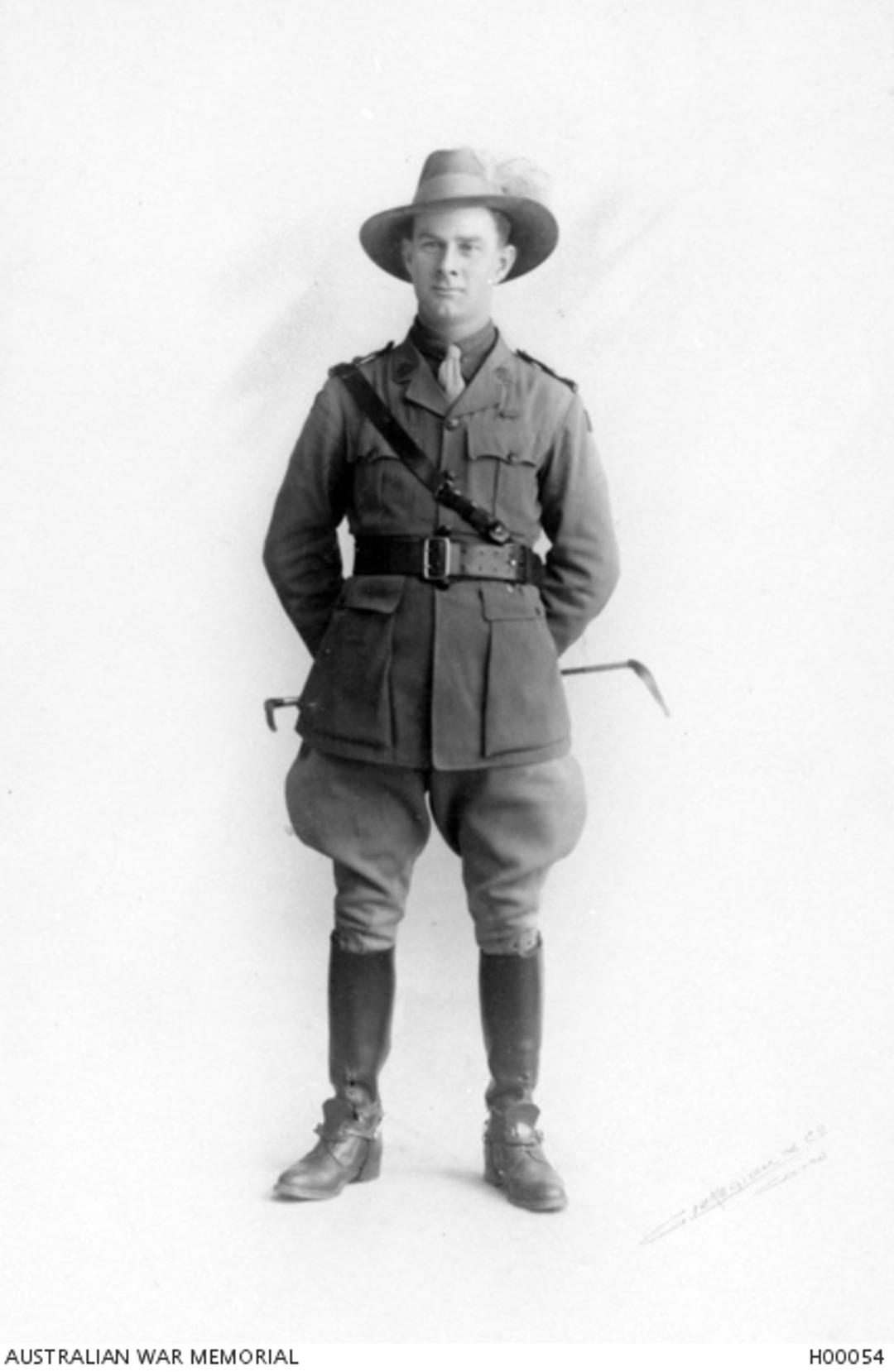Claudius
Vessel Name: Claudius
Joseph Ingonaoe
Loeloe Kintoe
Bire Manoe
Thimotioes Nali
Mezak Fek
Drowned at Sea; Bodies of Ingonaoe, Kintoe, Manoe and Nali recovered; Hand of Fek recovered
30 June 1942

The dinghy of the Claudius was in perfect condition

The Claudius Registration

Henry McLachlan MacNee World War 1
In many ways, Henry “Harry” Maclachlan Macnee embodies the Australian spirit – An adventurer, pearler, pearling captain and agent, war hero and contributor to public life. Much has been documented about his exploits.
On the other hand, the lives of 5 indentured Koepangers who lost their lives in 1942 when sailing his vessel from Broome to Fremantle, under the instructions of the Department of the Navy, are not well known at all. “Koepangers” were from Kupang in Timor and even their correct name and age has proved difficult to ascertain.
The Claudius (B.52) was built in Fremantle in 1910 by Alfred E. Brown. It was 41 feet long, with a 13 foot beam, carvel built wooden pearling lugger with two masts. It had a gross tonnage of 18.49 tons. In the 1920’s the Claudius was owned by the Western Australian Pearler’s Association who utilised it as a training lugger for Chinese workers.
The Claudius had been purchased on the 17 September 1931 from the previous owner by Macnee on a promissory note at a value of £600. The vessel was rebuilt in 1936/37 at a cost of £550 when it was lengthened to 47 feet (53 feet overall) and a 2 cylinder, 20 B.H.P semi-diesel H.M.G engine was fitted costing £350. The contractors who did the re-build were Hezo Matsuura as first carpenter and two other Japanese assistors. All three were later interned as enemy aliens during World War 2. At the time of requisition in 1942, it was owned in entirety by Macnee. He also owned another Pearling Lugger, the Kim, and utilised Japanese and Koepanger crew to man his boats. Each boat had permits for 9 persons.
The Claudius and the Kim were requisitioned temporarily for defence purposes by Lieutenant D. L. Davis acting as purchasing officer for the Department of the Navy. Vessels needed to be delivered strictly by 10am on the 18 February 1942. The following day, the first Japanese attacks on Darwin occurred, and by the 3 March Broome was attacked by a fleet of Imperial Japanese Navy Air Fighters using Kupang in Timor as their launching base.
The Claudius and other luggers escaped harm and were chartered at a rate of 4/2d per day. Macnee appealed this rate and was later awarded 6/6d per day. Charter money at that rate was therefore payable for 133 days from 18 February 1942 until its loss on 30 June 1942 (totalled £43.4.6d). The vessel was uninsured and it was acknowledged in the compensation claim, that even during peacetime, insurance companies would not carry the risk of any boat worth more than £300, and the premium at that amount was 8%. He was paid £1000 as compensation for the loss of the vessel by the Department of the Navy. Macnee also disputed this amount when compared to the compensation paid for the Gloria (£1500) which he felt was an inferior vessel. Macnee had put in a claim for £1350 but accepted £1000 for compensation.
By June 1942, in convoy with others, the lugger was battling through heavy seas on her way to Fremantle From Broome to escape Japanese activity on the Northern coastline. Onboard the Claudius were 5 indentured Koepangers well known to the Pearling grounds in Broome. They were;
Joseph Ingonaoe (33), (also spelt Joseph Inganre)
Loeloe Kintoe (24), (also spelt Loeloe Kitoe)
Bire Manoe (41), (also spelt Beri Manu)
Thimotioes Nali (70), (also spelt Timothius Nalle)
Mezak Fek
One of the first persons to spot the lugger in difficulty was well-known Scarborough fisherman Dick Briggs who noted at 2:30pm the vessel was flying a red flag. He got in touch with Detective Sergeant Harry Jackson of the Criminal Investigation Branch, who notified Perth Police. By about 3pm the lugger had drifted to within 500 yards of the beach and seemed to have anchored on to rock. At around 5pm a Navy patrol vessel came on the scene but failed to get safely close enough to assist the stricken crew. By then, however, the crew seemed satisfied with their anchorage, because the red flag was lowered. Briggs kept the craft under observation with field glasses. Johnny Le Varre, another well-known Scarborough fisherman and surf life-saver was also standing by to render assistance. At dusk the lugger was situated about half a mile from shore and there were indications that the anchor was holding and that the craft had a good chance of seeing the night out safely.
The next morning a scene of tragedy greeted early visitors to the beach. All that could be seen was a mass of litter along the coast for about a quarter of a mile. There were hatch covers, broken masts, oil drums, a sea chest containing documents, the top of the cabin, mattresses, sections of the decking, and the preserved dinghy with its paddles. The hull itself was under water about 150 yards from the south beach. The irony of the tragedy highlighted by the lugger’s dinghy and paddles – found safely after floating ashore undamaged. It gave the first clue of the identity of the wrecked lugger with its stern and paddles displaying the number “B.52”.
What happened during the night, no one will ever accurately know. Whether the crew were asleep in their bunks when the lugger drifted free and was splintered on the rocks or whether they leaped overboard and attempted to swim for shore, cannot be ascertained. Police and Naval patrols searched for survivors. Four days after the tragedy, the bodies of 3 of the crew were recovered from the surf at Cottesloe. The body of the 4th man was washed ashore at North Cottesloe on 9 July. Although the beaches were constantly patrolled, the body of the 5th man was never recovered. All 4 men were buried in Fremantle Cemetery in the Anglican section. 12 days after the tragedy, a human hand, severed at the wrist, tumbled on to the beach at Cottesloe. Fingerprints definitely established is as that of the missing man – Mezak Fek. The human hand was placed in a large bottle of preserving liquid and placed in the Police museum in James Street in Perth.
A memorandum from Naval Officer in Charge, Fremantle dated 11 August, 1942 stated;
“Between Geraldton and Fremantle are three luggers ashore B.16, B.42, and B.47. As already reported to you, these boats were stranded on the 28th June, 1942, whilst on passage to Fremantle in a sudden heavy westerly storm. The Commonwealth Salvage Board are taking steps to refloat these vessels. B.52 Claudius was completely smashed up on a reef during the same gale.”One of the three otherluggers was forced ashore at Whitford’s Beach, north of Scarborough. Protruding from the sand were the rotting remains of that lugger, but the crew managed to get ashore when the vessel grounded. It was speculated that had the crew of the Claudius allowed the vessel to reach the beach without the use of the anchor in tow it was likely they would have survived.
Henry “Harry” Maclachlan Macnee was born in 1887 in Melbourne and spent his youth growing up in Northcote, Victoria. He lost his Father John at age 9, and his Mother Mary at age 16. After working as a clerk In Melbourne he headed to West Australia with some friends to work on the land, but by 1911 he turned his attention to Pearling in Broome and later his two younger brothers Kenneth and Jack joined him there. On one occasion, when out in charge of a boat manned by four divers of mixed races he was caught in a storm. The men desired to cut away the mast, but, saying that he would not have the firm's property destroyed, he ordered them to the ropes and with loaded rifle kept them there during the long hours through which the storm raged. Forty-eight hours later he sailed back into Broome after having been given up as lost. He served abroad with the Australian Imperial Forces for five years during World War 1. He lost his brother Kenneth in 1917 whilst serving in Belgium during World War 1. Harry himself served with the 10th Australian Light Horse Regiment where he was awarded the Distinguished Conduct Medal whilst fighting on Hill 60 in the Dardanelles in 1915, and the Military Cross for his service in Egypt in 1919. He returned to Broome in 1920 and married Elizabeth May Smith in 1924, later having two children; Kenneth (named after his deceased brother) and Jean. He remained in Broome until 1942 when he re-joined the military forces. At the time of the tragedy, Macnee had been called up for Military duty and was stationed in Kalgoorlie where he served as the Brigade Major of the Volunteer Defence Corps (VDC). He later became Adjutant of the Fremantle Battalion of the VDC. He was later appointed as a member of the State Transport Board representing rural industries. His son Kenneth tragically died in 1945 at age 16 at a Private Hospital in Perth.
